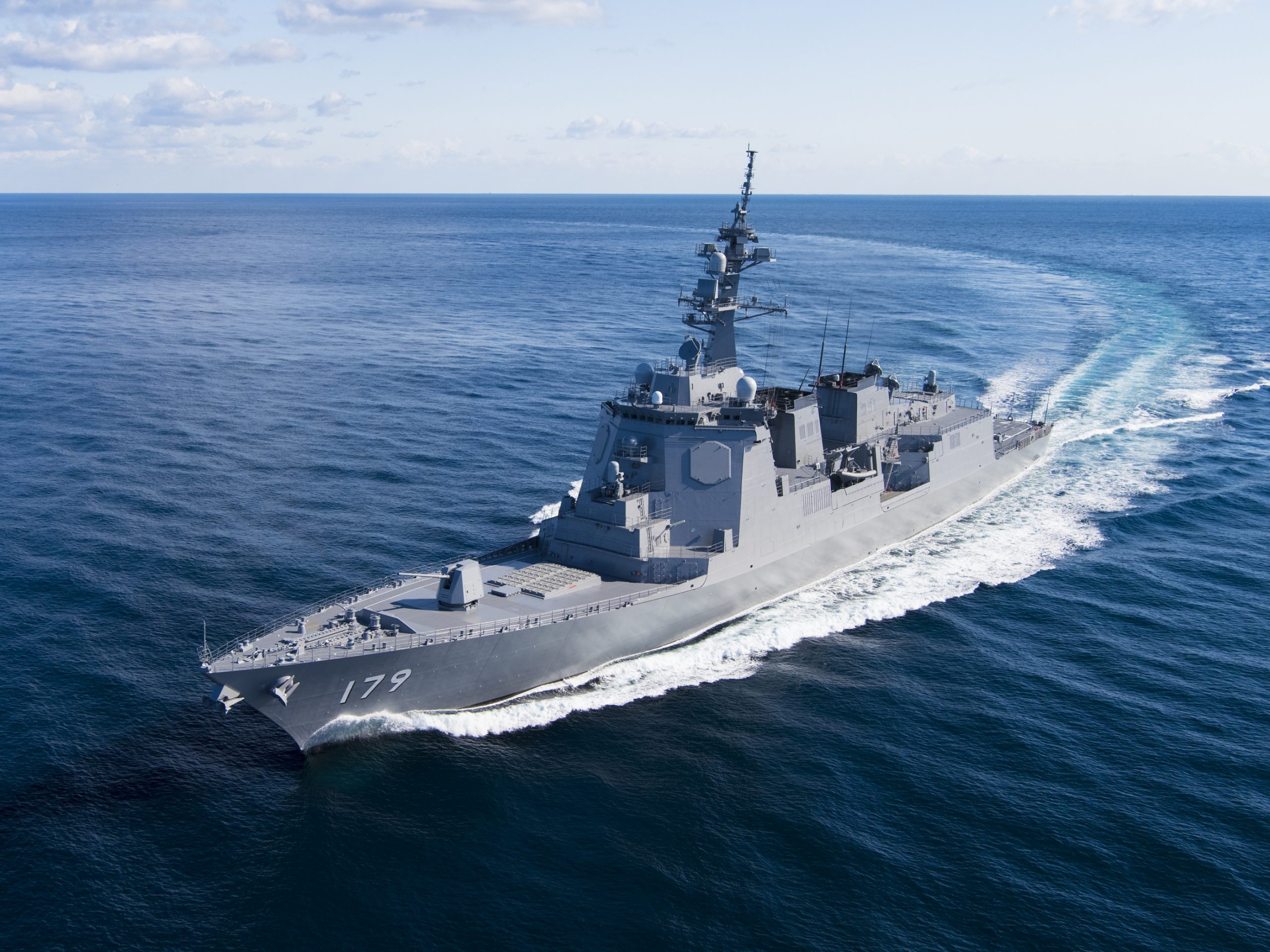企業戦略 2021.06.18
CS27 アテナの盾(イージス) Shield of Athena(Aegis)
For those who prefer to read this column in English, the Japanese text is followed by a British English translation, so please scroll down to the bottom of the Japanese text.
海上自衛隊の最新鋭イージス護衛艦「はぐろ」が、まや型護衛艦の2番艦として建造され、本年2月19日、海上自衛隊に引き渡された。この佐世保に配備された「はぐろ」は、同時に相当数の目標をミサイルで攻撃できる最新鋭のイージス・システムが搭載され、初期の「こんごう型」、第2世代の「あたご型」から更に進化した第3世代と呼ばれる最新鋭のイージス艦である。
更なる特長は、これまでのイージス艦に比べ弾道ミサイルへの対応力が格段に強化されている点である。その射程距離は「これまでの倍以上2000キロに達する」と言われており、また対艦ミサイルでも、純国産の「SSMS-3」と呼ばれる最新型が搭載されている。味方の艦船や航空機とネットワークを結び、レーダー情報をリアルタイムで共有するCEC(共同交戦能力)を備え日本の防空の中核を担う、この「はぐろ」の配備でイージス艦8隻によるミサイル防衛の態勢が整い、そのうち4隻が佐世保に配備されることになった。

護衛艦「まや」型イージス艦 Aegis destroyer “MAYA
(出典:海上自衛隊ホームページ)(Source: JMSDF website)
1.イージス
イージス、英語で「Aegis」とは、ギリシャ神話の最高神ゼウスが娘アテナに与えたとされている「あらゆる邪悪を払う盾、アイギス(Aigis)」のことである。このアイギスに由来する、イージス・システム(Aegis System)は、米海軍によって防空戦闘を重視して開発された艦載武器システムである。
イージス・システムの根幹を成すものは、敵の姿を明確、的確に捉える「レーダー」のシステムである。英国の物理学者、ジェームズ・クラーク・マクスウェルによって電磁波の存在が理論的に予言されていたが、19世紀末ドイツの物理学者ハインリヒ・ヘルツがおこなった実験によって、「電磁波の存在」が証明された。この実験で証明された理論に基づいて、ドイツ、英国で「電磁波の反射」によって「対象物を明らかにする」実験が行なわれ、徐々に「レーダー」の初期型が姿を顕わしていった。
人類の歴史に於いて多くの発明がなされるキッカケとなる出来事は「戦争」である。第一次世界大戦が終わり、その賠償問題に端を発した第二次世界大戦の萌芽が徐々に顕われだした1930年代の後半、「レーダーが軍事技術として大きく発展、進化すること」になった。まずドイツでその実用化がなされ、続いて英国が1941年に本格的なレーダーの開発に成功、英国本土への空襲の防備に大いに寄与した。こうしてレーダーは戦略武器として各国で開発が急ピッチで進められていったのである。

2.八木・宇田アンテナ
このレーダーは、実は日本の科学者、八木東北帝国大学教授と宇田東北帝国大学教授が共同開発した「八木・宇田アンテナ」の技術によって大きく進化したものである。
それまでの技術に比べ、容易に指向性を得ることができる画期的な技術であったが、日本では全く評価されることはなかった。しかし、欧米では非常に評価されこの新しく開発された技術によってレーダーの技術開発が急速に進むことになったのである。この八木・宇田アンテナは非常に完成度の高い技術であり、それから100年近く経った今でも家庭用テレビのアンテナとして広く使用されているものである。
このことに関して、昨年2020年2月本コラムに投稿した「RM 17ーレーダー(「魚焼きの網」)Radar (”gridiron”)」に以下を記した。
2.日本人研究者の発明により飛躍的に進化
レーダーの主要部品は2つ、「発振器」と「アンテナ」である。米国、英国をはじめとした諸外国のレーダー開発には、主要部分に日本人の発明が利用されていた、「八木・宇田アンテナ」と「分割陽極型マグネトロン」である。したがって、「レーダーは、日本人が発明、制作した」と言っても過言ではない。
八木・宇田アンテナは、八木秀次と宇田新太郎という日本人研究者の研究成果であり、魚の骨のような簡単な構造で、優れた性能(鋭い指向性と高い利得)が得られたことが利点であった。今でもテレビの受信アンテナとして広く使われているアンテナである。このアンテナは、日本では誰にも注目されなかったものの、1926年英語で論文を発表したところ、米国で大いに賞賛された発明品である。
一方、発振器「分割陽極型マグネトロン」もまた、日本人研究者である岡部金治郎が、1927年に発表したものであった。それまで米国で開発されていた単陽極マグネトロンでは不可能だった、高い周波数(マイクロ波)の発振を可能としたうえ、かつ高効率であり、レーダーの実用化に向けて、性能を飛躍的に高める研究成果であった。
1920年代に、日本人研究者によりこれらの画期的な新技術が生み出されていたにもかかわらず、日本の陸海軍はその研究の成果をレーダー開発につなげることはできなかった。海軍では、「これからの海戦にレーダーが必要かどうか」という議論が盛んになされた一方で、事業化に進むための具体的な検討はずっと低調であった。「ノーベル賞の後追いでおこなわれる文化勲章の授与」等が典型的な例であるが、日本で認められずに海外で認められて日本に逆輸入されることが多いが、昔からそうであったのである。リスク認識が甘いのである。
しかし、米国と英国をはじめとする諸外国では、これらの研究成果を早期に事業化し、通信機器やレーダーの開発に応用したのであった。リスクマネジメントを真剣に考える組織との違いである。旧日本軍は、「情報を活かすことを考える部門、人が欠落していて、『精神論』ばかりが一人歩きする組織であった証拠」であろう。
これは旧日本軍だけであろうか。現代の企業の組織で、この「レーダーのような発明や新たな革新的な取り組みを活かす組織」は存在するのであろうか。リスクを評価、リスクへの対応を決め企業の戦略に大きな効用を本来与える組織がリスクマネジメント部門であるが、果たして企業のなかで「企業戦略への貢献」を強く期待される組織としての位置づけになっているのであろうか。
日本企業に昔の輝きがなくなってきていると言われている理由の一端はこのあたりではないだろうか。「新しいモノ」をやろうとすると、まず「それは無理だ、過去に例がない」等、新しい取り組みをするにも関わらず、過去の「経験論」を持ち出す、江戸時代のような会話がいまだにまかり通っている企業も多いのではないだろうか。
3.イージス・システム
従来、海を航行する艦船を空の脅威から防備することを目的とした艦対空ミサイル・システムでは、その脅威の対象は1〜2個の目標に対処するものであった。しかし、「ミサイルの進化によって、多くのミサイルが飛来する」という新たなリスクに対応するため、米海軍では1960年代はじめより新たな防空システムの開発を始め、10年以上の歳月を掛けて完成したものがイージス・システムであった。
イージス・システムは、従来のような単なる防空システムという枠にとどまらず、「味方の防備の武器、攻撃の武器を一元的に統括して対応する、統合的な戦闘システムとして構築されたもの」である。「脅威の発見」、「防備の対応」そして「迎撃、攻撃」というシステムが統合されたものであり、その「心臓部」となる存在がイージス艦である。このシステムによって同時に対応可能な脅威・目標は128以上といわれている。しかし、イージス艦は「国防の要」であり最重要軍事機密という点から、公表されたその値が正しいものであるかどうかは定かではない。
イージス艦は高性能であるがゆえ非常に高価であり一隻の価格は2000億円を超える武器であるが、この最低限「公表されたデータ」から読み解いても、その「抑止力」としての効用からも、決して「高い買い物ではない」といわれている。

今回のまとめ
太平洋戦争に於いて、米軍に比べて旧日本軍が一番技術的に劣後していた「武器」がレーダーであった。このレーダーの性能によって勝敗の行方が決まった戦いが、ミッドウェー海戦であった。また、この海戦は「互いの艦艇を視界に入れずに戦った、史上初の海戦、レーダーの戦いであった」と言われ、太平洋戦争の雌雄を決し日本の命運を決定づける戦いとなったのである。
レーダーの性能を決める使用電波の波長は、当時日本では、メートル波、しかも何十メートルという段階であったが、英国、米国では使用電波の波長がすでにメートル波からセンチ波へと進歩、それによって測定精度も大幅に向上していた。その差の背景は、理論的にはわかっていても日本では真空管の製造が追いつかなかったためである。トックリのような形の電球式真空管で苦心惨憺していたのである。その頃、アメリカは既に金属真空管の製造へどんどん進んでいたため、レーダーの大幅な精度の向上が可能になっていたのである。
皮肉なことに「レーダーの要」を発明したのは日本の科学者達であった。「海外で認められて初めて日本で認められる構図」は、戦前のこの「レーダーの開発」に限らず、前述の通り、今でも起きている。「ノーベル賞受賞後の文化勲章の授与」である。この背景にあるものは何だろうか、それは「受賞者の選定をする立場の組織」にその選定に関して充分な知見が無いからであると言われている。しかし、「日本を代表する頭脳」に対して「栄誉授与の優先順位付けをすること」である。相当に困難な仕事であると言わざるを得ない。評価する以上、同程度以上の「頭脳」が要求されるからである。
これと同じ事がリスクマネジメントの世界にも存在している。リスクマネジメントとは「企業が、組織がリスク対応すべき対象を選定」して、「有効な対応策を立案、選択すること」である。しかし、企業や組織に内在する、また遭遇するリスクは、列挙していくと、その数がかなりの数に上り、「リスクマネジメント=リスクの列挙と対応策の選定」という尺度でリスクマネジメントを測ると、「あれもこれも対応せざるを得ない=時間が無い」という大きなトラップに陥ってしまうことになってしまうからである。
その時「プロフェッショナルが用いる手法」が「リスクの計量化=数値化」と、それによる「リスク対応への優先順位付け」である。これこそがリスクマネジメントの際に最も重要な「ステップ」となるのである。
だからこそ、リスクマネジメントの作業には専門家の存在が必須であり、グローバル・リンクがキャプティブを視野にした本格的なリスクマネジメントを推奨している理由がここにあるのである。
執筆・翻訳者:羽谷 信一郎
English Translation
CS27 – Shield of Athena – Aegis
The Japan Maritime Self-Defense Force (JMSDF)’s most advanced Aegis destroyer, Haguro, the second of the Maya class destroyers, was built and delivered to the JMSDF on 19 February this year. Deployed in Sasebo, the Haguro is equipped with a state-of-the-art Aegis system capable of striking a significant number of targets simultaneously with missiles.
A further advantage of the Aegis is that it is much more capable of dealing with ballistic missiles than previous Aegis ships. Its range is said to be “more than twice as long as any other Aegis missile”, reaching 2,000 kilometres, and it is also equipped with the latest generation of anti-ship missiles, the SSMS-3, which is manufactured entirely in Japan. The deployment of the Haguro completes the missile defence capability of the eight Aegis ships, four of which will be deployed in Sasebo.
1. Aegis
Aegis, in English, refers to the shield that Zeus, the supreme god of Greek mythology, is said to have given to his daughter Athena to ward off all evil. From this Aigis comes the Aegis System, a shipboard weapon system developed by the US Navy with an emphasis on air defence.
At the heart of the Aegis System is the radar system, which provides a clear and precise view of the enemy. The existence of electromagnetic waves had been theoretically predicted by the British physicist James Clerk Maxwell, but experiments carried out by the German physicist Heinrich Hertz at the end of the 19th century proved the existence of electromagnetic waves. On the basis of this theory, experiments were carried out in Germany and England to reveal objects by the reflection of electromagnetic waves, and gradually the first forms of radar emerged.
In the history of mankind, war has been the starting point for many inventions. In the second half of the 1930s, after the end of the First World War and the beginning of the Second World War, which was triggered by the issue of reparations, radar began to develop and evolve as a military technology, first in Germany, and then in Britain in 1941, when it was successfully used to prevent air raids on the British mainland. In this way, the development of radar as a strategic weapon was promoted at a rapid pace in many countries.
2. The Yagi-Uda antenna
The radar was in fact greatly advanced by the technology of the “Yagi-Uda antenna”, jointly developed by the Japanese scientists Professor Yagi and Professor Uda of the Tohoku Imperial University.
It was an epoch-making technology which could easily obtain directionality compared to the previous technology, but it was not appreciated at all in Japan. In Europe and the United States, however, it was very well received, and this newly developed technology led to the rapid development of radar technology. The Yagi-Uda antenna was so perfected that it is still widely used as a household television antenna 80 years later.
I wrote about it in my article “RM 17 – Radar (“gridiron”)” in this column last February 2020.
2. The Radar (“gridiron”) is a breakthrough invention by Japanese researchers.
Radar has two main components: the oscillator and the antenna. In the development of radar in the United States, Britain and other countries, Japanese inventions were used for the main parts: the Yagi-Uda antenna and the split-anode magnetron. Therefore, it is not an exaggeration to say that radar was invented and produced by the Japanese.
The Yagi-Uda antenna was the result of the work of two Japanese researchers, Hidetsugu Yagi and Shintaro Uda, and its advantage was that it had a simple structure like a fish bone, with excellent performance (sharp directivity and high gain). This antenna is still widely used as a television receiving antenna. Although this antenna did not attract much attention in Japan, it was a much-lauded invention in the USA, where it was published in English in 1926.
On the other hand, the oscillator “split-anode magnetron” was also published in 1927 by a Japanese researcher, Kinjiro Okabe. The oscillator was able to oscillate at higher frequencies (microwaves) than was possible with the single-anode magnetrons developed in the USA, and was highly efficient, a result of his research which dramatically improved the performance of radar for practical use.
Despite these revolutionary new technologies being developed by Japanese researchers in the 1920s, the Japanese Army and Navy were unable to translate the results of their research into radar development. In the Navy, while there was much debate about whether radar was necessary for future naval warfare, concrete studies to commercialise the technology were much slower. The awarding of the Order of Culture after the Nobel Prize is a typical example of this. This has always been the case.The risk perception is not good enough.
However, the US, UK and other countries were quick to commercialise these research results and applied them to the development of communications equipment and radar. This is the difference between an organisation that takes risk management seriously. The former Japanese military was “evidence of an organisation that lacked departments and people who thought about making the best use of information, and where only ‘mentalism’ walked alone”.
Is this only true of the old Japanese army? Are there any modern corporate organisations that make use of this “radar-like invention and new innovative approaches”? The risk management department is the organisation that assesses risks, decides how to deal with them and essentially makes a significant contribution to the company’s strategy, but is it really positioned as an organisation that is strongly expected to contribute to the company’s strategy?
This may be one of the reasons why Japanese companies are said to be losing their old glory.Whenever they try to do something new, the first thing they say is “that’s impossible, there’s never been anything like it before”, and even though they are trying to do something new, they bring up the “empiricism” of the past. This is the kind of conversation that still prevails in many companies, just like in the Edo period.
3. Aegis system
Traditionally, ship-to-air missile systems, designed to protect ships at sea from air threats, have been designed to target one or two targets. However, as missiles evolved, the US Navy began developing a new air defence system in the early 1960s to deal with the new risk of “many missiles in the air”, and after more than a decade of development, the Aegis system was completed.
The Aegis system was not just an air defense system, but an “integrated combat system that integrates and responds to friendly defensive and offensive weapons”. It is an integrated system of threat detection, defensive response, interception and attack, with the Aegis at its heart. The Aegis is the “heart” of this system, which is said to be capable of responding to more than 128 threats and targets simultaneously. However, in view of the fact that the Aegis is a “key element of national defence” and a top military secret, it is not certain that these published figures are correct.
Because of their high performance, Aegis ships are very expensive weapons, costing in excess of 200 billion yen per ship, but at the very least, the “published data” suggests that they are “not expensive” in terms of their “deterrent” effect.
Summary of this issue
In the Pacific War, the most technologically inferior “weapon” of the former Japanese Army compared to the US Army was radar. The Battle of Midway was a battle in which victory or defeat was decided by the performance of this radar. It is said that this was the first naval battle in history in which both sides fought without being able to see each other’s ships, and it was a battle that decided the fate of Japan and the Pacific War.
The wavelength of the radio waves used to determine the performance of radar was, at that time in Japan, metre waves, and at the stage of tens of metres, but in Britain and the United States, the wavelength of the radio waves used had already advanced from metre waves to centimetre waves, and this had greatly improved the accuracy of measurement. The reason for this difference was that the production of vacuum tubes in Japan could not keep up with the theoretical requirements. They were struggling to produce a light bulb vacuum tube in the shape of a tokkuri (a sake decanter). At that time, the United States was already making progress in the production of metal vacuum tubes, which made it possible to improve the accuracy of radar significantly.
Ironically, it was Japanese scientists who invented the “key to radar”. The “first to be recognised abroad, first to be recognised in Japan” pattern was not limited to the pre-war development of radar, but, as mentioned above, still occurs today. This is the case not only with the development of radar before the war, but also with the awarding of the Order of Culture after the Nobel Prize. It is said that this is due to the fact that “the organization in charge of selecting the laureates” does not have sufficient knowledge about the selection process. But to prioritise the awarding of honours to “one of Japan’s leading minds”? It must be said that this is a very difficult task.The reason is that the same or higher level of “brains” is required to evaluate them.
The same is true in the world of risk management. Risk management is the process by which a company or an organisation selects the risks to which it is exposed, and develops and selects an effective response. However, the number of risks inherent in and encountered by companies and organisations can be quite large, and measuring risk management in terms of “risk management = listing of risks and selection of countermeasures” can lead to a big trap of “having to deal with this and that = no time”.
The “professional approach” is to quantify risk and prioritise risk responses based on that quantification. This is the most important “step” in risk management. This is why the work of risk management requires the presence of experts, and why Global Link recommends full-scale risk management with a view to captives.
Author/translator: Shinichiro Hatani

